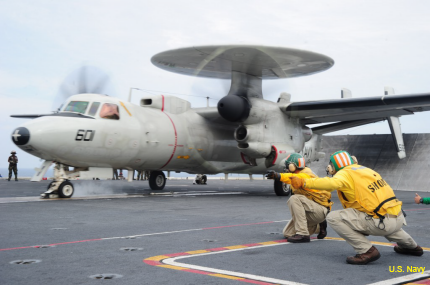Navy's maritime strategy puts emphasis on 'all domain access'
The document, updated from 2007, stresses the importance of cyberspace and the electromagnetic spectrum in national security.

An E-2C Hawkeye tactical early warning aircraft gets set to take off.
The Navy’s newly released maritime strategy, updated from 2007, reflects the changing environment of military operations by putting a heavy focus on “all domain access”—that is, protecting and making use of cyberspace and the electromagnetic spectrum.
The plan, titled “A Cooperative Strategy for 21st Century Seapower,” and released last week, covers operations for the three forces that patrol maritime areas of command – Navy, Marines and Coast Guard and sets forth all domain access as a key metric in seapower as it supports national security.
All domain access, defined as “the ability to project military force in contested areas with sufficient freedom of action to operate effectively,” is threatened by both state and non-state actors, the document states. Enemies are increasingly employing anti-access/area denial (A2AD) strategies that put current advanced weapon systems at risk.
Cross-domain capabilities are employed by Navy and Marine Corps teams to combat such threats through various elements. Battlespace awareness, for example, provides persistent surveillance capabilities of maritime and littoral environments and allows for extensive knowledge of enemy intent, capabilities, operational insight and a more comprehensive assessment of the environment in which friendly forces are participating. Assured command and control provides commanders with the ability to “maintain robust, resilient, and agile networks for the command and control of forces in contested environments.”
Cyberspace operations, which include both defensive and offensive measures, assist in protecting data, networks, net-centric capabilities as well as additional design systems. Cyberspace operations also enable friendly forces to preserve friendly network and cyberspace capabilities while projecting power within the domain as a whole. The next element within cross domain capabilities is Electromagnetic Maneuver Warfare, which while a relatively new concept, blends fleet operations in space, cyberspace and the electromagnetic spectrum to create distinct advantages. Lastly, integrated fires provide expanded range of kinetic and non-kinetic options for commanders to utilize and attack adversary vulnerabilities.
The significance of cross-domain synergy, or the event in which all these elements are synchronized, is that they give joint force commands the capabilities and options in all domains to thwart A2AD strategies. The new maritime strategy provided the example of defeating anti-ship and cruise missile threats through superior battlespace awareness, which will provide commanders with significant insight on deploying other defensive or offensive measures, depending on the nature of the threat. Electromagnetic Maneuver Warfare in combination with an integrated fires approach, for example, could defeat missile threats before they are launched.
The key to ensuring effective access in all domains, the strategy states, is to develop those capabilities during peace time in order to maximize relationship-building with partners and joint force commands.




